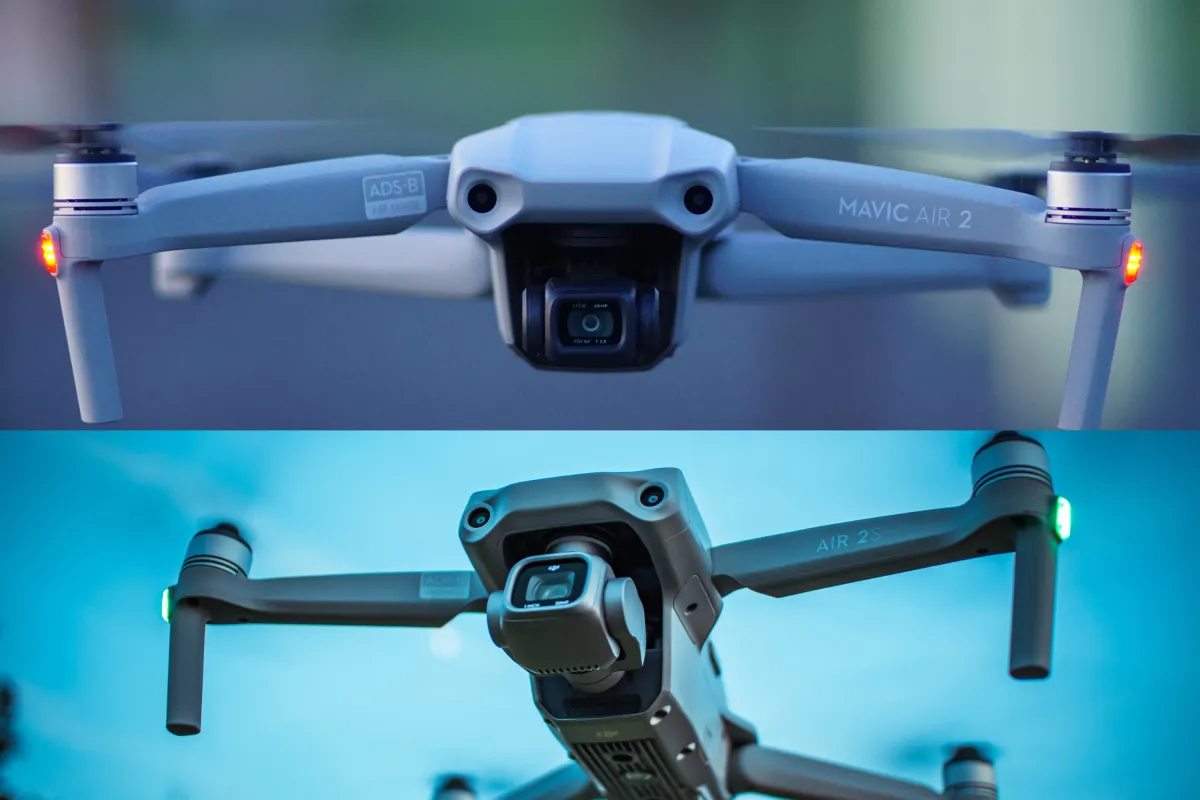
DJI Mavic Air 2 vs DJI Air 2S: Discover Aerial Superiority
Choosing the perfect drone involves a meticulous examination of specifications and performance. In this comprehensive exploration of DJI Mavic Air 2 vs DJI Air 2S, we intricately dissect the features of each drone, guiding you to make an informed decision for your upcoming aerial adventures.
DJI Mavic Air 2 vs DJI Air 2S: Design and Portability
Weight and Size:
The Mavic Air 2, weighing a mere 1.26 lbs / 570g, is a marvel of engineering, combining robust features with a lightweight design. Its foldable structure, measuring 7.08×3.82×3.31 inches / 180×97×84mm when folded, ensures great portability.
The Air 2S, at 1.31 lbs / 595g, adds a touch of sophistication to its design. Its folded dimensions of 7.08×3.82×3.03 inches / 180×97×77mm maintain portability without sacrificing performance.
Flight Performance:
The Mavic Air 2 takes flight with an impressive flight time of up to 34 minutes, allowing you to capture extensive footage on a single charge. Ascending at a rate of 8.9 mph (4 m/s) and descending at a maximum of 11 mph (5 m/s), it strikes a balance between agility and stability.
Meanwhile, the Air 2S slightly trims the time of up to 31 minutes but compensates with faster ascent and descent speeds of 13 mph (6 m/s), offering dynamic and efficient flight maneuvers.
Portability:
Both drones showcase DJI's commitment to portability, featuring a foldable design that fits snugly into your backpack. The Mavic Air 2 and Air 2S redefine on-the-go convenience without compromising on performance.
Why Choose: Whether you opt for the Mavic Air 2's extended flight time or the Air 2S's efficient flight maneuvers, both drones guarantee a seamless blend of performance and portability.
DJI Mavic Air 2 vs DJI Air 2S: Camera Performance
Sensor and Resolution:
The heart of any drone lies in its camera, and here, the Air 2S takes a step ahead. With a larger 1" CMOS sensor boasting 20 MP, it captures more light and detail compared to the Mavic Air 2's 1/2" CMOS sensor offering 12 MP and 48 MP. This distinction implies superior image quality for the Air 2S, especially in challenging lighting conditions.
Video Resolution, and Frame Rates:
Delving into specifics, the Mavic Air 2 supports video resolutions up to 4K Ultra HD at 60 fps, 2.7K at 60 fps, and FHD including 120 and 240 fps for smooth slow-motion footage.
On the other hand, the Air 2S supports video resolutions up to 5.4K at 30 fps, offering unparalleled clarity. Other resolutions include 4K Ultra HD at 60 fps, 2.7K at 60 fps, and FHD at 120 fps. The higher bitrate of 150 Mbps ensures your videos are not just vivid but exceptionally detailed.
Color Profiles and Zoom:
Both drones feature color profiles like D-Cinelike and Normal, allowing you to customize the look of your videos. The Mavic Air 2 and Air 2S also incorporate zoom capabilities, providing creative flexibility. The Mavic Air 2 offers digital zoom options, while the Air 2S introduces a more advanced zoom feature, ensuring detailed shots even in challenging scenarios.
Why Choose: The Air 2S's superior sensor, ISO range, and max resolution contribute to unparalleled image quality, especially in low-light conditions. Its advanced video capabilities, including higher resolutions and bitrates, make it the preferred choice for those seeking cinematic footage. However, the Mavic Air 2, with its robust camera setup, remains an excellent choice for enthusiasts seeking a balance between performance and affordability.
DJI Mavic Air 2 vs DJI Air 2S: Flight Performance
Speed and Wind Resistance:
The Mavic Air 2's 42.5 mph (19m/s) max horizontal flight speed ensures you can capture fast-paced scenes with precision. With wind resistance of 8.5-10.5m/s, it's a reliable companion in various weather conditions. The Air 2S maintains the same speed but introduces a higher wind resistance of 10.7m/s, providing enhanced stability in challenging environments.
Gimbal Stabilization:
Both drones feature a 3-axis gimbal, ensuring your footage remains stable and professional even during dynamic flight maneuvers. This stabilization technology guarantees smooth videos, allowing you to focus on capturing the perfect shot.
Why Choose: The Mavic Air 2's impressive flight speed and stability make it an excellent choice for capturing dynamic scenes. For those seeking additional stability in windy conditions, the Air 2S raises the bar, ensuring your footage is steady and captivating.
DJI Mavic Air 2 vs DJI Air 2S: Intelligent Flight Modes
Obstacle Avoidance and Safety:
The Mavic Air 2 employs the Advanced Pilot Assistance Systems (APAS) 3.0 for a 3-way advanced obstacle avoidance, enhancing your flying experience. The Air 2S takes safety to the next level with a more sophisticated 4-way sensing system, including O3 transmission technology, potentially providing an extra layer of security during flights.
Both drones come equipped with Follow Me features. However, the Air 2S takes it a step further by offering an enhanced Follow Me functionality and introducing the innovative MasterShots feature. MasterShots is an intelligent and automated shooting mode designed to elevate your storytelling capabilities.
Why Choose: Safety is paramount in aerial adventures, and both drones offer advanced obstacle avoidance systems. If you prioritize cutting-edge safety features, the Air 2S offers an additional layer of reassurance.
DJI Mavic Air 2 vs DJI Air 2S: Remote Controller Features
Transmission System:
Both drones feature the OcuSync transmission technology, ensuring a reliable connection between the drone and the remote controller. The Mavic Air 2 offers OcuSync 2.0, and the Air 2S introduces O3, enhancing connectivity and potentially extending your transmission range.
Max Transmission Distance:
The Mavic Air 2 boasts an impressive 6.2 miles / 10km max transmission distance, providing you with ample room for exploration. The Air 2S takes it a step further, offering an extended range of 7.4 miles / 12km (FCC), ensuring you can capture stunning footage from greater distances.
Why Choose: For enthusiasts who crave connectivity and the freedom to explore vast landscapes, the Air 2S's extended transmission range offers limitless possibilities.
Conclusion: Elevate Your Aerial Experience
In the ever-evolving world of drone technology, the Mavic Air 2 and Air 2S stand as a testament to the innovation DJI brings to the table. Although considered "older," both drones continue to offer unparalleled features, combining reliability with advanced capabilities.
Why Choose: If you're seeking a drone that balances affordability with high-end features, the Mavic Air 2 is an exceptional choice. However, for those who desire top-notch image quality, enhanced transmission, and an array of creative possibilities, the Air 2S is an investment in an elevated aerial experience.
FAQs - Your Questions Answered:
Which drone is better for professional photography – DJI Mavic Air 2 or DJI Air 2S?
The Air 2S, with its larger sensor, advanced ISO range, and higher resolution, is specifically crafted for photography enthusiasts aiming for professional-quality shots.
Do these drones have follow-me modes for action shots?
Both the Mavic Air 2 and Air 2S feature intelligent follow-me modes, ensuring you capture dynamic action shots effortlessly. Air 2S provides an upgraded ActiveTrack feature.
Can these drones be flown in windy conditions?
While the Mavic Air 2 exhibits impressive wind resistance, the Air 2S takes it a step further, providing enhanced stability in challenging weather conditions.
Is it worth upgrading from the Mavic Air 2 to the Air 2S?
If you prioritize advanced camera capabilities, extended transmission range, and enhanced safety features, upgrading to the Air 2S is a worthwhile investment.
What accessories are recommended for enhancing drone performance?
Consider accessories like additional batteries, ND filters, and a quality carrying case to enhance your overall drone experience, ensuring you're fully equipped for every adventure.
Explore further in articles from ieee.org and the British Ecological Society here.

Copyright © Drone Guide Central - All Rights Reserved 2024

